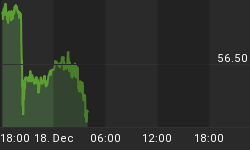A potentially completed Elliott wave count on the crude oil futures charts suggests that traders will benefit from having a bullish bias during the next several months. Here we show how the pattern resolved with last week's low, and we offer some initial milestones and a timeline for a potential upward move.
For much of 2014, we had been following the large downward 'C' wave in crude oil futures. The end of wave C should mark a significant low. The monthly chart below shows how price reached some square-of-nine targets at 44.88 and 38.43, and you can also discern the five-wave structure of the decline from 2013. On a monthly time frame, the move can be complete.

The weekly chart for continuous-contract futures shows a classic five-wave structure for downward wave C, with the third wave being the strongest, while the second and fourth waves are proportionate to each other. We had been using three main Fibonacci-related supports as possible targets for the end of the downward fifth wave, and price appears to have found support near the central target of $38.00.
Going forward, the first major confirmation signal that traders might watch for on a weekly time frame will be a break of the upper channel boundary shown on the continuous-contract chart. Price obeyed the geometry of the channel throughout 2014 and early 2015, and breaking out of that geometry should reignite some interest in long positions.

Since the termination of downward wave C represents completion of a pattern, there is not yet enough information about the next chart pattern to project upward targets. However, we believe price is likely to trade in a sideways-upward fashion, probably staying within the range between the recent low and the price area that was broken last autumn. Our cycles analysis for crude oil products suggests that the sideways-upward phase should persist until the early months of 2016.
It is not a certainty that downward wave [v] of C has finished. Traders looking upward should allow for the possibility that price needs to make one more lower low before it can break out of the downward pattern.
Markets are becoming more volatile now. Discover how much your profits can increase with expert guidance in finding the trades. Subscribe to Trading On The Mark today!















